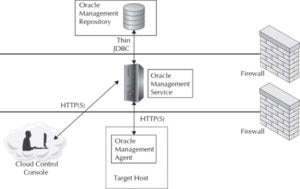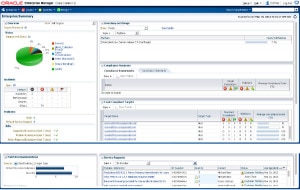- Cloud Control Console The Cloud Control Console is a browser-based application through which administrators can centrally manage their entire computing environment. If you had to choose one image to define the big picture for Cloud Control, it would have to be the Console home page:
- Oracle Management Agent The Management Agent, installed on each managed host, monitors the host and all targets on that host, and communicates information about these targets to the OMS. Targets can be Oracle and non-Oracle components installed on the host. Cloud Control monitors over 200 different target types; each instance of a particular target type counts as a monitored target. Examples of commonly used target types are Database Instance, Listener, Oracle Application Server, and Host.
- Oracle Management Service The OMS is a Java 2 Platform Enterprise Edition (J2EE) middle-tier application that renders the user interface for the Console. Agents upload target-related data to the OMS, which then processes this data before uploading it to a data store, the Oracle Management Repository. The Cloud Control middle tier consists of an Oracle WebLogic Server 10.3.5 instance, which deploys the Management Service J2EE Web application.
You must install the OMS on at least one or more hosts as needed to support your environment for scalability or high availability. Each Management Service must reside on its own host. The OMS and Management Repository can reside on the same host, but for performance reasons, Oracle does not recommend this configuration for a production Cloud Control environment, unless it is small (fewer than 1,000 targets). All physical OMS hosts independently provide the generic Oracle Management Service, though multiple OMS hosts with a Shared Directory can coordinate to process Agent upload files to this directory.
At the time of this writing, the OMS was certified to run on Linux x86-64 and x86, Oracle Solaris on SPARC (x64), Oracle Solaris on x86-64 (64-bit), IBM AIX on POWER Systems, and Windows x86-64. Plans are to certify the OMS on Windows x86 and HP-UX (Itanium, PA-RISC), which are already certified for the Agent.
- Oracle Management Repository The Repository (OMR) is the data store for Cloud Control, created either during the CC installation in a pre-installed Oracle database or by the EM template in DBCA when creating the database. The Repository is located in the SYSMAN schema, which contains information on all Cloud Control targets and administrators. The Repository organizes this data so that the OMS can retrieve and display it in the Console for any administrator with privileges to view it. A Cloud Control infrastructure uses just one central Repository database. It can be a single-instance or RAC Oracle database, releases 10gR2 (10.2.0.5), 11gR1 (11.1.0.7.0), or 11gR2 (11.2.0.1+), although Oracle Database 11.2 is recommended.
- An administrator requests content in the Console over HTTP(S) in a browser session, which the OMS renders. The OMS then retrieves the data for the request from the Management Repository and displays it in the Console.
- Agents upload information to the OMS over HTTP(S), and the OMS uploads this data via thin JDBC to the OMR. The OMR sends data back to the OMS over thin JDBC, which is relayed to the Agent via a built-in HTTP listener.


Leave a Reply